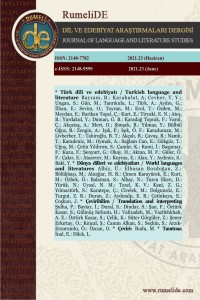Bilmecelerde metaforik dil üzerine
Abstract
İnsan, sosyal bir varlık olarak çevresi ile sürekli etkileşim halindedir. Bu etkileşim; davranışlara, bilişsel sürece ve iletişimin merkezinde yer alan dile de yansımaktadır. Sosyal hayatta edinilen deneyimler, bilişsel şemalar aracılığıyla yeni öğrenmelere ve anlamlandırmalara kapı aralar. Sözlü kültür ürünü olan bilmeceler de halkın duygu, düşünce ve deneyimlerinden izler taşıyan, kalıplaşmış sözlerdir. Bazı bilmece örneklerinde görülen metaforik yapı, bilmeceyi oluşturan bilişsel süreci ve temel düşünceyi de göstermektedir. Bu yönüyle bilmeceler, toplumsal bilincin söyleme dönüştüğü metaforik dil örnekleridir. Bu çalışmada, konularına göre sınıflandırılmış bilmece örneklerinden yola çıkılarak bilmecelerdeki metaforik yapı tespit edilmeye çalışılmıştır. Bilmecenin karşılığı ile soru kısmı arasında kavramsal düzeyde gerçekleşen aktarımlar, bireysel ve toplumsal deneyimleri gösteren metaforları işaret etmektedir. Kavramsal haritalama, kaynak alanı oluşturan soru kısmı ile hedef alanı oluşturan cevap kısmı arasında gerçekleşmektedir. İki alan arasındaki ontolojik ve epistemik uygunluk, bilmecenin cevabı ile öznesi arasındaki eşleşmelerle sağlanmaktadır. Diğer bir deyişle bilmecenin öznesi ile cevabı arasında imaj şemaya dayalı bir yapılandırma söz konusudur.
Keywords
References
- Aksan, D. (1971). Kelime bilimi ve Anlambilimi Ölçülerinden Yararlanarak Bir Yazı Dilinin Eksikliğini Saptama Yolları I: Kavram Alanı-Kelime Ailesi İlişkileri ve Türk Yazı Dilinin Eskiliği Üzerine. Türk Dili Araştırmaları Yıllığı - Belleten, 19, 253-262.
- Aksan, D. (2016). Anlambilim. Ankara: Bilgi.
- Başgöz İ. ve Tietze A. (1999). Türk Halkının Bilmeceleri. Ankara: Türk Tarih Kurumu.
- Boratav, P. N. (1997). 100 Soruda Türk Halk Edebiyatı. İstanbul: Gerçek.
- Cankara, M. (2002). Metafor Yaratma Eylemi Olarak Bilmece. Milli Folklor, 55, s.70-75.
- Çobanoğlu, Ö. (1999).Halkbilimi Açısından Gelenek, Turizm ve İcat Edilmiş Gelenek Bağlamında Ayvalık Şeytan Sofrası Örneği. Milli Folklor, 43, 7-12.
- Elçin, Ş. (1989). Türk Bilmeceleri. Ankara: Kültür Bakanlığı.
- Johnson, M. (2005). The philosophical significance of image schemas. From Perception to Meaning Cognitive Linguistics Research 29, R. Dirven, R. W. Langacker, J. R. Taylor (eds.), Mouton de Gruyter Berlin-New York, 15-33.
- Karademir, F. (2008). Halk Bilmecelerindeki İmgesel Anlatım Üzerine. Milli Folklor, 78, 75-87.
- Kövecses, Z. (2010). Metaphor: A Practical Introduction. New York: Oxford University Press.
- Lakoff, G. (1987). Women, Fire and Dangerous Things: What Categories Reveal About the Mind. Chicago and London: University of Chicago Press.
- Lakoff, G. ve Johnson M. (2015). Metaforlar, Hayat, Anlam ve Dil. çev. Gökhan Yavuz Demir, İstanbul: İthaki.
- Levine, P. M. (2005). Metaphors and images of classrooms. Kappa Delta Pi Record, 41(4), 172-175.
- Selvi, C. (2020). Türk Bilmecelerinin Anlambilim Açısından İçlem (Alt Anlam) ve Kaplam (Üst Anlam) Sınıflandırması. E. Kuyma (ed.), Mana’ya Dair, İstanbul: Kesit, 163-182. Tezel, N. (2004). Türk Halk Bilmeceleri. İstanbul: MEB.
On metaphorical language in riddles
Abstract
As a social being, human beings are in constant interaction with their environment. This interaction is reflected in behaviors, cognitive processes and language, which is at the center of communication. Experiences gained in social life lead to new learning and interpretations through cognitive schemes. Riddles, which are products of oral culture, are stereotyped words that bear traces of the feelings, thoughts and experiences of the people. The metaphorical structure seen in some riddle examples also shows the cognitive process and basic thought that make up the riddle. In this respect, riddles are examples of metaphorical language in which social consciousness is transformed into utterance. In this study, the metaphorical structure in the riddles were tried to be determined by starting from the examples of riddles classified according to their subjects. The conceptual transference between the answer of the riddle and the question part points to metaphors showing individual and social experiences. Conceptual mapping occurs between the question part forming the source domain and the answer part forming the target domain. The ontological and epistemic coherence between the two fields is provided by the matches between the answer to the riddle and its subject. In other words, there is a structuring based on image schema between the subject of the riddle and its answer.
Keywords
References
- Aksan, D. (1971). Kelime bilimi ve Anlambilimi Ölçülerinden Yararlanarak Bir Yazı Dilinin Eksikliğini Saptama Yolları I: Kavram Alanı-Kelime Ailesi İlişkileri ve Türk Yazı Dilinin Eskiliği Üzerine. Türk Dili Araştırmaları Yıllığı - Belleten, 19, 253-262.
- Aksan, D. (2016). Anlambilim. Ankara: Bilgi.
- Başgöz İ. ve Tietze A. (1999). Türk Halkının Bilmeceleri. Ankara: Türk Tarih Kurumu.
- Boratav, P. N. (1997). 100 Soruda Türk Halk Edebiyatı. İstanbul: Gerçek.
- Cankara, M. (2002). Metafor Yaratma Eylemi Olarak Bilmece. Milli Folklor, 55, s.70-75.
- Çobanoğlu, Ö. (1999).Halkbilimi Açısından Gelenek, Turizm ve İcat Edilmiş Gelenek Bağlamında Ayvalık Şeytan Sofrası Örneği. Milli Folklor, 43, 7-12.
- Elçin, Ş. (1989). Türk Bilmeceleri. Ankara: Kültür Bakanlığı.
- Johnson, M. (2005). The philosophical significance of image schemas. From Perception to Meaning Cognitive Linguistics Research 29, R. Dirven, R. W. Langacker, J. R. Taylor (eds.), Mouton de Gruyter Berlin-New York, 15-33.
- Karademir, F. (2008). Halk Bilmecelerindeki İmgesel Anlatım Üzerine. Milli Folklor, 78, 75-87.
- Kövecses, Z. (2010). Metaphor: A Practical Introduction. New York: Oxford University Press.
- Lakoff, G. (1987). Women, Fire and Dangerous Things: What Categories Reveal About the Mind. Chicago and London: University of Chicago Press.
- Lakoff, G. ve Johnson M. (2015). Metaforlar, Hayat, Anlam ve Dil. çev. Gökhan Yavuz Demir, İstanbul: İthaki.
- Levine, P. M. (2005). Metaphors and images of classrooms. Kappa Delta Pi Record, 41(4), 172-175.
- Selvi, C. (2020). Türk Bilmecelerinin Anlambilim Açısından İçlem (Alt Anlam) ve Kaplam (Üst Anlam) Sınıflandırması. E. Kuyma (ed.), Mana’ya Dair, İstanbul: Kesit, 163-182. Tezel, N. (2004). Türk Halk Bilmeceleri. İstanbul: MEB.
Details
| Primary Language | Turkish |
|---|---|
| Subjects | Linguistics |
| Journal Section | Turkish language, culture and literature |
| Authors | |
| Publication Date | June 21, 2021 |
| Published in Issue | Year 2021 Issue: 23 |

